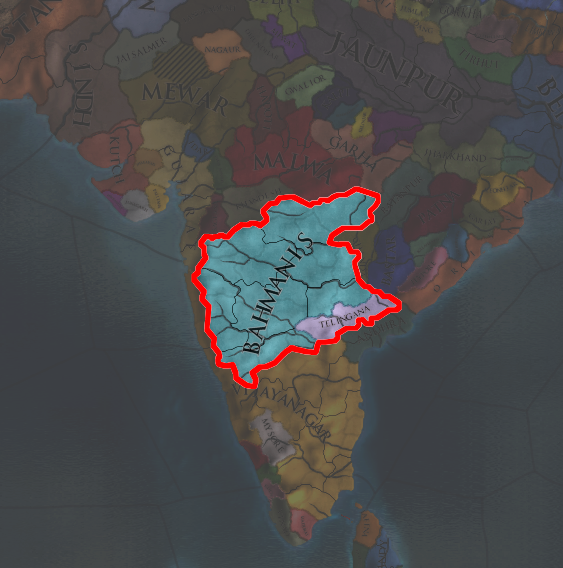.png)
Yes, We Dec-can!
An EU4 1.34.5 Bahmanis AAR
Table of Contents
Historical Context and Starting Postion
Act 1 - The Indian Hegemon (1444-1550)
Chapter 1 - Free Vassals are the Best Vassals
Chapter 2 - The Fall of Vijayanagar
Chapter 3 - The Calm before the Storm
The Bahmani Sultanate - Historical Context
During most of the Middle Ages, the Indian subcontinent was dominated by the Delhi Sultanate, a powerful persianate state emerging from the rapid dissolution of the Ghurid Empire in 1206. This state would be ruled by five dynasties (it being on the final years of its fourth in 1444) over the more than three centuries it existed, but in stark difference to the dynastic games of Europe these had no blood ties with one another and are simply lumped together by claiming the same title and employing the same, but of course over the centuries evolving, methods to legitimate their rulership. (please do not commence in discussions if the Mughals were in fact the sixth Delhian dynasty)
The Tughlaq dynasty was arguably the most powerful of these five ruling clans, for under them the empire reached its greatest territorial extent in the year 1330. However the ruler that achieved this zenith, Muhammad bin Tughluq, was not exactly the most cautious of rulers and would initiate the collapse of his dynasty through wild policy swings and borderline megalomaniacal territorial ambitions - he wanted to extend his reach to Baghdad in the west and convert China to Islam.
It was from this collapse that the Bahmani Sultanate emerged. Ala-ud-Din Hasan Bahman Shah, born as Zafar Khan, served as regional governor of the Deccan under the Tughlaqs as their empire started to fray, and by 1347 had become the independent ruler of this rising power in southern India.
While there was obviously a lot of different things going on over the decades, the two main drivers of the sultanate's history were its ceaseless conflicts with the Empire of Vijayanagar to its south, as well as a further persianization of the societal elite, even compared to the already heavily persianized societies of muslim India.
The Bahmani Sultanate would start to decline at the turn of the 16th century, losing power to five successor sultanates (Bijapur, Ahmednagar, Berar, Golconda, and Bidar) before its last holdouts were stamped out by Vijayanagar. However it would be an alliance of these five Deccan Sultanates that would topple the Vijayanagara Empire a few decades later, ushering in a period of squabbling (relatively) minor polities in southern India before Aurangzib of the Mughal Empire would come knocking.
Starting Position


On November 11, 1444; Bahmanis is one of the dominant powers in southern/central India, together with its eternal rival in Vijayanagar. It borders the aforementioned major Hindu power in the south and west, Gujarat in the north-west, Malwa in the north, and various minor tribal kingdoms in the east. It possesses no coastal province at gamestart, but has several cores to reclaim along India's western shoreline. Bahmanis, Vijayanagar, Jaunpur, and Bengal form what I consider the "Big Four" of India, and if the subcontinent is left in AI hands it's usually those four that divide it among them. If looking at intial development Bahmanis (201) seems to be beaten by Vijay (263) and Jaunpur (212), but the numbers somewhat lie here. Vijay starts with essentially half the country at high local autonomy and with unaccepted culture so it actually starts with a weaker economy than Bahmanis. And Bahmanis has a special trick that lets it beat Jaunpur as well:
Golconda
+4.00 Goods Produced from the "Diamonds of Golconda" modifier is equal to an extra 20 production development. And considering that this province produces Gems, which are an excellent trade good for the first century or so, this province has a decent case for being the best non-goldmine province in the game. But even aside from this supercharged province Bahmanis' economy is strong owed to the excellent tradegoods of India. Its home tradenode kind of stinks, but so do all Indian nodes in my opinion. Gotta push to
However, Bahmanis' most outstanding feature is its religion, for it starts as one of the only eight Shiite countries in 1444. This has a few minor downsides (harder to make allies with other Muslims), but a lot of significant upsides (Deus Vult against the world, DotF without being called to arms after the other Shiites die, ez cash and cheap tech through sitting at high Legalism due to wars).
Bahmanis' national idea set is rather mediocre all things considered, but it is also the only nation that can form Deccan without switching culture and/or religion. And while Deccan is a tech 20 formable, its idea set is absolutely excellent, probably the second best of all Indian tags after the Mughals.
With all these factors going in its favor, I personally consider Bahmanis to be the strongest of all countries starting in India.
Last edited:

